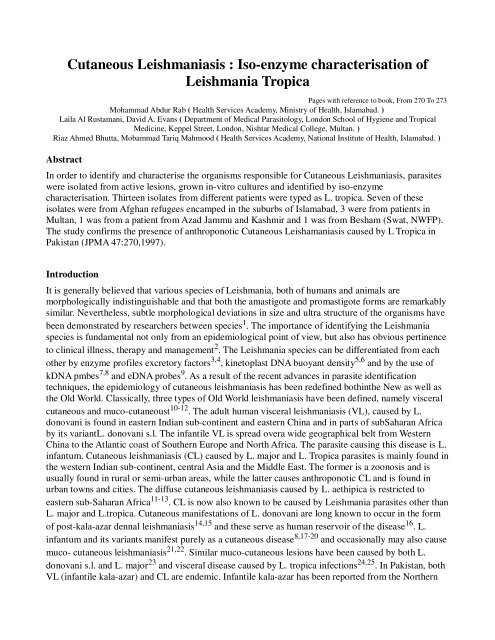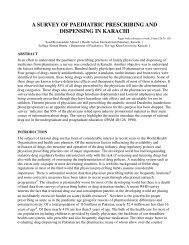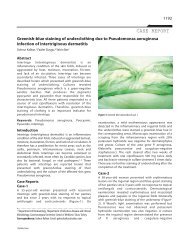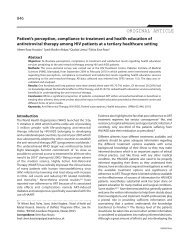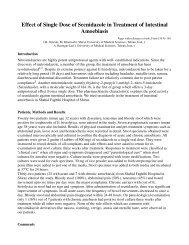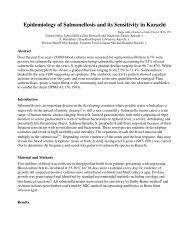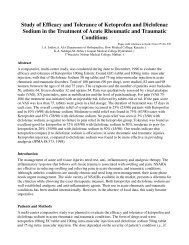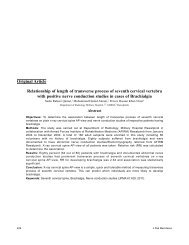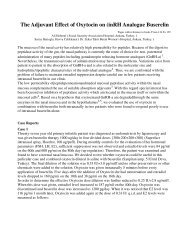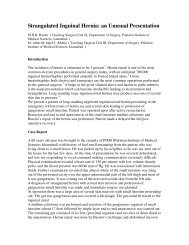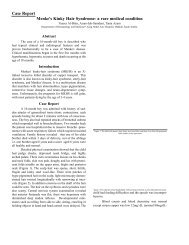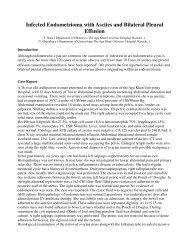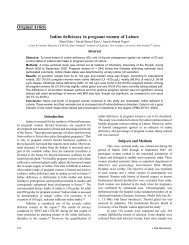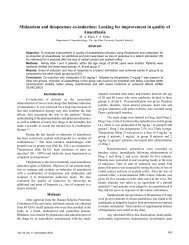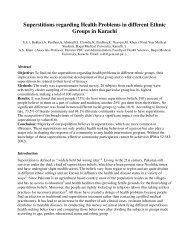Cutaneous Leishmaniasis : Iso-enzyme characterisation of ...
Cutaneous Leishmaniasis : Iso-enzyme characterisation of ...
Cutaneous Leishmaniasis : Iso-enzyme characterisation of ...
You also want an ePaper? Increase the reach of your titles
YUMPU automatically turns print PDFs into web optimized ePapers that Google loves.
<strong>Cutaneous</strong> <strong>Leishmaniasis</strong> : <strong>Iso</strong>-<strong>enzyme</strong> <strong>characterisation</strong> <strong>of</strong><br />
Leishmania Tropica<br />
Pages with reference to book, From 270 To 273<br />
Mohammad Abdur Rab ( Health Services Academy, Ministry <strong>of</strong> Health, Islamabad. )<br />
Laila Al Rustamani, David A. Evans ( Department <strong>of</strong> Medical Parasitology, London School <strong>of</strong> Hygiene and Tropical<br />
Medicine, Keppel Street, London, Nishtar Medical College, Multan. )<br />
Riaz Ahmed Bhutta, Mobammad Tariq Mahmood ( Health Services Academy, National Institute <strong>of</strong> Health, Islamabad. )<br />
Abstract<br />
In order to identify and characterise the organisms responsible for <strong>Cutaneous</strong> <strong>Leishmaniasis</strong>, parasites<br />
were isolated from active lesions, grown in-vitro cultures and identified by iso-<strong>enzyme</strong><br />
<strong>characterisation</strong>. Thirteen isolates from different patients were typed as L. tropica. Seven <strong>of</strong> these<br />
isolates were from Afghan refugees encamped in the suburbs <strong>of</strong> Islamabad, 3 were from patients in<br />
Multan, 1 was from a patient from Azad Jammu and Kashmir and 1 was from Besham (Swat, NWFP).<br />
The study confirms the presence <strong>of</strong> anthroponotic <strong>Cutaneous</strong> Leishamaniasis caused by L Tropica in<br />
Pakistan (JPMA 47:270,1997).<br />
Introduction<br />
It is generally believed that various species <strong>of</strong> Leishmania, both <strong>of</strong> humans and animals are<br />
morphologically indistinguishable and that both the amastigote and promastigote forms are remarkably<br />
similar. Nevertheless, subtle morphological deviations in size and ultra structure <strong>of</strong> the organisms have<br />
been demonstrated by researchers between species 1 . The importance <strong>of</strong> identifying the Leishmania<br />
species is fundamental not only from an epidemiological point <strong>of</strong> view, but also has obvious pertinence<br />
to clinical illness, therapy and management 2 . The Leishmania species can be differentiated from each<br />
other by <strong>enzyme</strong> pr<strong>of</strong>iles excretory factors 3,4 , kinetoplast DNA buoyant density 5,6 and by the use <strong>of</strong><br />
kDNA pmbes 7,8 and eDNA probes 9 . As a result <strong>of</strong> the recent advances in parasite identification<br />
techniques, the epidemiology <strong>of</strong> cutaneous leishmaniasis has been redefined bothinthe New as well as<br />
the Old World. Classically, three types <strong>of</strong> Old World leishmaniasis have been defined, namely visceral<br />
cutaneous and muco-cutaneoust 10-12 . The adult human visceral leishmaniasis (VL), caused by L.<br />
donovani is found in eastern Indian sub-continent and eastern China and in parts <strong>of</strong> subSaharan Africa<br />
by its variantL. donovani s.l. The infantile VL is spread overa wide geographical belt from Western<br />
China to the Atlantic coast <strong>of</strong> Southern Europe and North Africa. The parasite causing this disease is L.<br />
infantum. <strong>Cutaneous</strong> leishmaniasis (CL) caused by L. major and L. Tropica parasites is mainly found in<br />
the western Indian sub-continent, central Asia and the Middle East. The former is a zoonosis and is<br />
usually found in rural or semi-urban areas, while the latter causes anthroponotic CL and is found in<br />
urban towns and cities. The diffuse cutaneous leishmaniasis caused by L. aethipica is restricted to<br />
eastern sub-Saharan Africa 11-13 . CL is now also known to be caused by Leishmania parasites other than<br />
L. major and L.tropica. <strong>Cutaneous</strong> manifestations <strong>of</strong> L. donovani are long known to occur in the form<br />
<strong>of</strong> post-kala-azar dennal leishmaniasis 14,15 and these serve as human reservoir <strong>of</strong> the disease 16 . L.<br />
infantum and its variants manifest purely as a cutaneous disease 8,17-20 and occasionally may also cause<br />
muco- cutaneous leishmaniasis 21,22 . Similar muco-cutaneous lesions have been caused by both L.<br />
donovani s.l. and L. major 23 and visceral disease caused by L. tropica infections 24,25 . In Pakistan, both<br />
VL (infantile kala-azar) and CL are endemic. Infantile kala-azar has been reported from the Northern
Areas 26,27 (N.A.). Azad Janunu and Kashmi? (AJK) and Baluchistan 29,30 ~ L. infantum has been<br />
identified as the causative organism <strong>of</strong> this disease, in patients from AJK and N.A. 31,32 . The same<br />
parasite has also been identified in isolates obtained from domestic dogs from AJK and N.A. 33 . Two<br />
types <strong>of</strong> CL, zoonotic CL and anthroponotic CL are endemic in different parts <strong>of</strong> the country 34 and the<br />
classification <strong>of</strong> CL in Pakistan has been based mainly upon the clinical features, epidemiology and<br />
sandfly fauna 34-36 . The identity <strong>of</strong> parasites causing CL in Pakistan has notyet been ascertained and this<br />
is the first report describing the isolation and <strong>characterisation</strong> <strong>of</strong> Leish.mania parasites from patients<br />
with cutaneous disease.<br />
Materials and Methods<br />
<strong>Iso</strong>lation <strong>of</strong> Leishmania parasites from CL patients<br />
Patients with suspected cutaneous leishmaniasis were referred to the National Institute <strong>of</strong> Health (NIH),<br />
from different hospitals in Islamabad for parasitological diagnosis, isolation and culture <strong>of</strong> the<br />
parasites. Samples were obtained from the indurated ulcer margins using a small serrated dental probe<br />
and inoculated in the bi-phasic NNN medium was also sent to Multan where aspiration/biopsy material<br />
from the lesions was inoculated into the medium and dispatched by couricr service to NIH in<br />
Islamabad, where the inoculates were maintained initially at NIH, Islamabad, until their shipment to the<br />
London School <strong>of</strong> Hygiene and Tropical Medicine, where they were frozen and stores in liquid nitrogen<br />
until further use.<br />
<strong>Iso</strong>enzy me characterization<br />
Princciples <strong>of</strong> enzy me electrophoresis: Soluble <strong>enzyme</strong>s are extracted fron the parasite and are placed<br />
in a gel matrix containing a buffer, the pH <strong>of</strong> which is pre-selected to render the iso<strong>enzyme</strong>s a negative<br />
charge. When a direct current is passed through the gel, the iso-<strong>enzyme</strong>s migrate through the matrix<br />
according-to their overall or net charge. As the net charges may be quantitatively different, iso<strong>enzyme</strong>s<br />
with the greatest negative charge move the farthest towards the anode, while those with the least<br />
negative charge travel the shortest. The bands <strong>of</strong> iso<strong>enzyme</strong>s are then visualized by appmpriate staining<br />
techniques.<br />
Preparation <strong>of</strong> samples<br />
The isolates stored in liquid nitregen were taken out, quickly, thawed quickly and inoculated in biphasic<br />
NNN medium37. In most cases the cultures grew well, however, in cases where the parasite<br />
revival was slow, inoculation in Sloppy Evans medium 37 was carried out. As soon as the organisms<br />
began to thrive and multiply rapidly in the initial agar medium, they were transferred to liquid medium<br />
(MEM:EBLB:FCS 37 ) for mass culture. In cases where growth was slow, the MEM:FEBLB:FCS<br />
medium was supplemented by the addition <strong>of</strong> 1% human urine obtained from a healthy individual and<br />
filtered through a 0.2 um Milipore filter (Sartonus AG) This greatly enhanced the growth <strong>of</strong> the<br />
promastigotes 38 . Log phase promastigotes (1x10 7) were harvested and washed 2x in PBSS (Proline<br />
Balance Salt Solution). The pallet was mixed with an equal amount <strong>of</strong> <strong>enzyme</strong> stabiiser (a mixture<br />
containing 2 mM each <strong>of</strong> Ethylene diamine tetra acetic acid, E- aminocaproic acid and Dithiothreitol).<br />
The final mixture was snap frozen and thawed 3x in liquid nitrogen and centrifuged at 10,000 0 for half<br />
an hour. The pallet was discarded and the supematant was stored as 15 uL beads (lysate) in liquid<br />
nitrogen until use.<br />
Starch Gel Electrophoresis<br />
Thin layer starch gel electrophoresis was carried out according to the previously described technique39.<br />
The gels were prepared using hydrolysed potato starch (Connaught Laboratories Limited), 7.5 gm/l00<br />
ml, in appropriate in gel (tank) buffer solutions. Linear slots were made in a straight line at regular<br />
intervals across the gel and samples applied using cotton thread (Anchor stranded embroideiy cotton)
cut in pieces <strong>of</strong> 8nun length and soaked in the lysate. The preparation <strong>of</strong> tank buffers, running time and<br />
the voltage requirements for electrophoresis was carried out as already defmed 39 .<br />
List <strong>of</strong> <strong>enzyme</strong>s studied.<br />
i)Alanine amino transferase (EC 2.6. 1.2), ii) Aspartate amino transferase (EC 2.6.1.1), iii)<br />
Superoxidase dismutase (EC 1.15.1.1), iv)Esterase (EC 3.1.1.1), v) Purine nucleoside hydrolase (EC<br />
3.2.3.1), vi) Mannose phosphate isomerase (EC 5.3.1.8), vii) Glucose phosphate isomerase (EC<br />
5.3.1.9), viii) Malate dehydrogenase (EC 1.1.1.37), ix) 6-Phosphogluconate dehydrogenase (EC<br />
1.1.1.44), x)<br />
Phosphoglucomutase (EC 2.7.5.1), xi) Proline iminopeptidase (EC 3.4.11.5) and xii) Pyruvate Kinase<br />
(EC 2.7.1.40).<br />
Results<br />
Inoculation <strong>of</strong> material from cutaneous lesions was carried out in 27 patients with CL. The age range<br />
was between 5 to 60 years. Clinically, all the lesions appeared to be <strong>of</strong> diy or urban (anthroponotic)<br />
type and the majority <strong>of</strong> these were either on the face or the hands and forearms. Parasites were grown<br />
in inoculates obtained from 16 patients. Seven isolates were from Afghan refugees encamped in the<br />
suburbs <strong>of</strong> Islamabad, 3 from Multan, 1 from a village north east <strong>of</strong> Rawalpindi, 1 from a patient from<br />
Bagh, AJK and 1 was from a patient who came from Besham in Swat (Kohistan district <strong>of</strong> NWFP).<br />
This patient had actually acquired his infection while working in Kuwait. <strong>Iso</strong><strong>enzyme</strong> <strong>characterisation</strong> <strong>of</strong><br />
13 isolates was performed. Standard WHO isolates <strong>of</strong> L. tropica and L. major were used as controls.<br />
The iso<strong>enzyme</strong> pattern <strong>of</strong> the iso<strong>enzyme</strong>s <strong>of</strong> L. donovani, L. infantum, L. tropica and L. major parasites<br />
on thin layer starch gel electrophoresis are graphically shown (Figure).
All thirteen isolates were characterised as L tropica (Table).
Discussion<br />
The Leishmania parasites causing visceral disease in Pakistan both in humans and in the dogs have<br />
been identified as L. infantum 31-33 . This report identifies L. tropica isolates obtained from patients with<br />
cutaneous lesion by iso<strong>enzyme</strong> <strong>characterisation</strong>. <strong>Iso</strong>lates obtained from patients <strong>of</strong> Afghan origin living<br />
in the vicinity <strong>of</strong> Islanmbad were typed as L. tmpica. Anthroponotic cutaneous leishmaniasis, the<br />
causative organism <strong>of</strong> which is L. tropica, is endemic in Afghanistan 12,14 , and the isolation <strong>of</strong> the<br />
parasite among the Afghan refugees suggests that the disease has been imported in this region from<br />
Afghanistan. The duration <strong>of</strong> the lesions in all these patients was under 8 months, therefore, the<br />
transmission <strong>of</strong> disease in these cases appeared to be indigenous, as the affected individuals had been<br />
residing in Pakistan for the last over eight years. Cases have also been observed among the locals and<br />
at least one isolate obtained from a young native girl has been typed as L. tropica. CL has also been<br />
described from the city <strong>of</strong> Multan in Southern Punjab, where the disease is endemic and occasionally<br />
may reachepidemic proportions 34 . <strong>Iso</strong>lates obtained from this area have also been typed as L. tropica,<br />
thus confirming the endemic parasite in this area. Similarly, this parasite has also been identified from<br />
atleast one case <strong>of</strong> CL from AJK. One isolate from a patient from Besham (Swat, NWFP) was also<br />
identified as L. tropica. This patient had acquired his infection while working in Kuwait, from where he<br />
had fled following the Iraq conflict. This parasite is endemic in most <strong>of</strong> the Middle East region<br />
including Saudi Arabia and Iraq 40,41 and therefore, the finding was not surprising, although L. major is<br />
also endemic in Kuwait 42 . It is not unusual forthe disease tobe imported into areas where it is not<br />
known to exist 43 . This has been made possible due to high frequency <strong>of</strong> international travel and<br />
lucrative facilities that are now available in some endemic countries, particularly the Middle East.<br />
Phiebotomus sargnti, the vector <strong>of</strong> L. tropica is found in most parts <strong>of</strong> Paldstan 44,45 , including the<br />
suburbs <strong>of</strong> Islamabad (personal communication, Dr. Mohamniad Arif Munir,NIH, Islamabad). The<br />
potential therefore, <strong>of</strong> spread <strong>of</strong> the disease in areas <strong>of</strong> the countiy hitherto non- endemic is high. The<br />
case from Besham (Swat, NWFP) was seen in 1991 and subsequently in. 1994, during the investigation
<strong>of</strong> a cholera outhreakinthe same area, one <strong>of</strong> the authors (MAR) saw acase <strong>of</strong> indigenously transmitted<br />
CL in an adult male.<br />
In the present study we did not identify L. major among our isolates, although it has been isolated and<br />
identified in strains obtained from Baluchistan alongwith L. tropica (personal communications from Dr.<br />
David A. Evans and M.A. Shahid DESTO Laboratories, Karachi, Pakistan). This parasite has been<br />
isolated from both humans and rodents in Western India, Central Asia, Middle East and Northern<br />
Africa 11,12,14,46 and infected rodents have been found in Baluchistan 47 . In conclusion, anthroponotic<br />
cutaneous leishmaniasis caused by L. tropica has been continued from both northern and southern<br />
Punjab, as well as AJK. The disease in northern Punjab appears to be imported from Afghanistan,<br />
however, it is endemic in the southern Punjab and AJK. Zoonotic CL is also highly endemic in many<br />
parts <strong>of</strong> the country, further studies are therefore needed to characterise and document L. major in<br />
Pakistan. Since L. infantum also causes cutaneous manifestations and is endemic in Pakistan, its role in<br />
the epidemiology <strong>of</strong> cutaneous leishmaniasis if any, needs.to be ascertained. Furthermore, the role <strong>of</strong><br />
dogs and rodents in cutaneous leishmaniasis in the countzy also needs investigation.<br />
Acknowledgements<br />
The authors wish to acknowledge the staff <strong>of</strong> the Dermatology Department <strong>of</strong> the Pakistan Institute <strong>of</strong><br />
Medical Sciences who referred some <strong>of</strong> the patients. The supportby the staff <strong>of</strong> the Immunology<br />
Department is also gratefully acknowledged. This work received financial support from the<br />
UNDPIWor1d Bank/WHO Special Programme for Research and Training in Tropical Diseases (TDR).<br />
References<br />
1. Chance, M.I. Problems in identification <strong>of</strong> parasites and theirvector. Symposia <strong>of</strong> the British Society<br />
for Parasitology Vol. 17. In: Eds. Taylor, A.E.R. and Muller, R. The identification <strong>of</strong> leishmania.<br />
Oxford, Blackwell Scientific Publication, 1979, pp. 55-74.<br />
2. Peters, W., Eans, D.A. and Lanham, S. Importance <strong>of</strong> parasite identification in cases <strong>of</strong><br />
leishmaniasis. J. R. Soc.Med., 1983;76:540-542.<br />
3. Schnur, L.F, Chance, M.L., Ebat, F. et al. The biochemical and serological taxonomy <strong>of</strong>visceralising<br />
leishmania. Ann. Imp. Med. Hyg., 1981:75:131-141.<br />
4. Mansour, N.S., Awadalla, H.N., Youssef, F.G, et al. Characterisation <strong>of</strong> Leishmania isolates from<br />
children with visceral infections contracted in Alexandria, Egypt. Trans. R. Soc. Trop. Med. Hyg.,<br />
1984;78:704.<br />
5. Peters, W., Chance, M.L., Mutinga, M.J. et al. The identification <strong>of</strong>human and animal isolates <strong>of</strong><br />
Leishmania from Kenya. Ann. Trop. Med. Parasitol., 1977;71:501-502.<br />
6. Chance, M.L., Schnur, L.F., Thomas, S.C. etal. Thebiochemical and serological taxonomy <strong>of</strong><br />
Leishmania from the Aethiopian zoological region. Ann. Trop. Med. Parasitol., 1978;72:533-542.<br />
7. Barker, D.C. and Butcher, J. The use <strong>of</strong> DNA probes in the identification <strong>of</strong> leishmaniasis:<br />
Distinction between isolates <strong>of</strong> L. Mexicans and L. Braziliences complexes. Trans. R. Soc. Trop.Med.<br />
Hyg., 1983;77:285-297,<br />
8. Ben-lsmail, R., Smith, D.F, Ready, P.D. eta!. Sporadic cutaneous leishmaniasis in north Tunisia:<br />
Identification <strong>of</strong>the causative agent as Leishmania infantumby the use <strong>of</strong> diagnostic deoxyribonucleic<br />
acid probe. Trans. R. Soc. Trop. Med. flyg., 1992;86:508-510.<br />
9. Howard, MK., Kelly, J.M., Lane, R.P. eta!. A aensitive repetitive DNA probe that is specific to the<br />
Leishmania donovani complex and its axe as an epidemiological agent. Mo!. Biochem. Parasitol., 1991<br />
;44:63-72.<br />
10. Lysenko, A.J. Distribution <strong>of</strong> leishmanissis in the Old World. Bull. WHO., 1971 ;44:5 12-520.
11. Desjeux, P. Human leishmaniasis: Epidemiology and public health aspects. World Health Stat. Q.,<br />
1992;45:267-275.<br />
12. WHO Technical Report Series No. 973. Control <strong>of</strong> the leishmaniasis: Report <strong>of</strong> a WHO expert<br />
committee, Geneva, WHO, 1990.<br />
13. Le Blancq, S.M., Belehu, A. and Peters, W. Old World 2: The distribution <strong>of</strong> L. aethiopica<br />
zymodemes. Trans. R. Soc. Trop.Med.Hyg., 1986;80:360-366.<br />
14. Ashford, R.W. and Bcttini, S. Ecology and Epidemiology: Old World. In: The leishmaniasis in<br />
Biology and Medicine, edited by Peters, W. and Killick-Kenddck, R. London, Academic Press, 1987.<br />
15. Beaver, P.C., Jung, R.C. and Cupp, E.W, Clinical Parasitology. 9th Edition.London, Lea and<br />
Feabiger, 1984, pp. 70-77.<br />
16. Addy, M. and Nandy, A. Ten years <strong>of</strong> kala-azsr in West Bengal. Part I. Did post kala-azar dermsl<br />
leishmaniasis initiate the outbreak in 24-paragnas. Bull. WHO., 1990;70:341-346.<br />
17. Kumar, P.V., Sadeghi, E. and Torabi, S. Kala-azar with disseminated dermal leishmaniasis. Am. J.<br />
Trop. Med. Hyg., 1989;40: 150-153.<br />
18. Rioux, J.A., Lanotte, G., Petter, F. et al. <strong>Cutaneous</strong> leishmaniasis in Westem Mediterranean basin.<br />
An eco- epidemiological analysis <strong>of</strong> three ‘foci’ in Tunisia, Morrocco and France. Edited by Rioux,J,A.<br />
Montpellier, Institute Mediterranean Epidemioloques et d’Etudes (IMEE), 1986, pp. 365-369.<br />
19. Rioux, J.A., Moreno, G., Lanotte, G. et al. Two episodes <strong>of</strong> cutaneous leishmaniasis in man caused<br />
by different zymodemea <strong>of</strong> Leishmania infantum s.I. Trans. R. Sdc. Trop. Med. Hyg., 1986;80: 1004-<br />
1006.<br />
20. Gramaccia, M., Gradoni, L. and Pozio, E. Leishmania infantum a.I as an agent <strong>of</strong> cutaneous<br />
leishmaniasis in Abruzzi region (Italy). Trans. R. Soc. Trop. Med.Hyg., 1987;81:235-237.<br />
21. Borzoni, N.K., Gradoni, F.B.L., Gramacia, M et al. A case <strong>of</strong> lingua! and palatine localisation <strong>of</strong> a<br />
viscerotropic Leisbmania infantum zymodeme in Sardinia, Italy. Trop. Med. Parasitol., 1991 ;42: 193-<br />
194.<br />
22. Alvar, J,, Bsllesteros, J.A., Soler, R. eta!. Muco-cutaneous leishmaniasis due to Leishmania<br />
infantum: biochemical characterization. Am. J. Trop. Med. Hyg., 1993;43:614-618.<br />
23. Ghalib, H.W, Eltoum, E.A., Kroon, CC. et al. Identification <strong>of</strong> Leishmania from mucosa!<br />
Icishmaniasis by recombinant DNA probes. Trans. R. Soc. Trop. Med. Hyg., 1992;86:158-160.<br />
24. Mebrahtu, Y., Lawyer, PG., Githur, J. I. et a!. Visceral leishmaniasis unresponsive to Pentostam<br />
caused by Leishmania tropica in Kenya. Am. J. Trop. Med. Hyg., 1989;41:289-294.<br />
25. Magil, A.J., Grog!, M., Gasser, R.A. et a!. Visceral infection caused by Leishmania tropica in<br />
veterans <strong>of</strong> operation desert storm. N. EngI. J. Med., 1993;328:1383-1387.<br />
26. Ahmed, N. and Burney, MI. Leishmanissis in Northem Areas <strong>of</strong> Pakistan. Armed<br />
F.Med.J.,1962;12:1-11.<br />
27. Bumey, M.I.,Lari, F.A. and Khan, MA. Status <strong>of</strong> visceral leishmanissis in Northern Pakistan.<br />
Trop.Doct., 1981; 11:146-148.<br />
28. Saleem, M., Anwar, C.M. and Malik, l.A. Visceral leishmaniasis in children: A new focus in Azad<br />
Kashmir J. Pak. Med. Assoc., 1986;36:230-233.<br />
29. Perver, Y., Bugti, A.N., Azeem, R. et al. Ka!a-Azar (Visceral <strong>Leishmaniasis</strong>) in Baluchistan. Pak.<br />
Pacd. J., 1992;16:225-227.<br />
30. Nagi, AG. and Nasimullah, M. Visceral leishmanissis in Baluchistan. Pak. Paed. J., 1993;17:7-10,<br />
31. Rab, M.A., Iqbal, J., Azmi, F.H. et a!. Visceral leishmaniasis: A seroepidemiological study <strong>of</strong> 289<br />
children from Endemic foci in Azad Jammu and Kashmir by Indirect Fluorescent Antibody Technique.<br />
J. Pak. Med. Assoc., 1989;39:225-228.<br />
32. Rab, MA. and Evans, D.A. Leishmania infantum in Himalayas.Trans. R. Soc. Trop. Med. Hyg.,<br />
1995;89:27-32.<br />
33. Rab, MA., Frame, LA. and Evans, D.A. The role <strong>of</strong> dogs in the epidemiology <strong>of</strong> humanviscera!<br />
leishmaniasis. Trans. R Soc. Trop. Med. Hyg., 1995;89:612-615.
34. Bumey, MI. and Lan, F.A. Status <strong>of</strong> cutaneous leishmaniasis in Pakistan. Pak. J.Med. Rca.,<br />
1986;25:101-108.<br />
35. Jan, SN. <strong>Cutaneous</strong> leishmaniasis in Baluchistan. Pak. J. Med. Rca., 1984;23:64-69.<br />
36. Rajper, G.M., Khan, MA. and Hafiz, A. Laboratory investigation <strong>of</strong> cutaneous leishmaniasis in<br />
Karachi. J. Pak. Med. Assoc., 1983;33 :248-250.<br />
37. Evans, D.A., Godfrey, D., Lanham, S. et a!. Leishmania: In: Handbook on isolation,<br />
chsracterisation and cryopreservation <strong>of</strong>Leishmania. Ed. Evans, D.A. Switzerland, UNDP/World<br />
Banki’TDR, 1989.<br />
38. Howard, M.K., Pharoah, M.M., Ashall, F. et al. Human urine stimulates growth <strong>of</strong> leishmania invitro.<br />
Trans. R. Soc. Trop. Med. Hyg., 1991 ;85 :477-479.<br />
39. Godfrey, D.G. and Kilgour, V. Enzyme clectrophoresis in characterising the causative organism <strong>of</strong><br />
Gambian Trypanosomiasis. Trans. R. Soc. Trop. Med. Hyg., 1976;70:219-224.<br />
40. Le Blancq, S. and Peters, W. Leishmania in the Old World: 2. <strong>Iso</strong><strong>enzyme</strong> charactenisation <strong>of</strong><br />
Leishmania tropics. Trans. R. Soc. Trop. Med. Hyg., 1986;80:113-119.<br />
41. A!jebori, TI. and Evans, GA. Leishmania spp: in Iraq. Electrophoretic iso<strong>enzyme</strong>pattems IL<br />
<strong>Cutaneous</strong> leishmaniasis. Trans. R. Soc. Trop. Med.Hyg., 1980;74: 178-184.<br />
42. Al-Taqi, M. and Evans, D.A. Characterization <strong>of</strong> Leishmania app. from Kuwait by iso<strong>enzyme</strong><br />
electrophoresia. Trana. R. Soc. Trop. Med. Hyg., 1978;72:56-65.<br />
43. Nautunne, T.D., Rajakulanderan, S., Abeywickreme, W. et a!. <strong>Cutaneous</strong> !eishmathasis in Sri<br />
Lanka. An imported disease linked to the Middle East and Africa employment boom. Trop. Geogr.<br />
Med., 1990;42:72-74.<br />
44. Lewis, D.J. The phlebotomine sandflies <strong>of</strong> West Pakistan (Diptera: Psychodidae). Bull. Br. Mus.<br />
(Nat. Hist.) Entomol., 1967;19:1-75.<br />
45. Nasir, AS. Sandflies as vector <strong>of</strong> human disease in Pakistan. Pak. J. Health, 1964;14:26.<br />
46. Peters, W., Chance, ML., Chowdhry, A.B. eta!. The identity <strong>of</strong> some stocks <strong>of</strong> Leishmania isolated<br />
in India. J. Trop.Med. Parasitol., 1981;75:247-249.<br />
47. Rab, MA., Armi, FA., Iqbal,J. et aL <strong>Cutaneous</strong> leishmaniasis in Baluchiatan: Reservoir host and<br />
sandfly vector in Uthal, Lasbella. J. Pak. Med. Aasoc., 1986;36:134-138.


